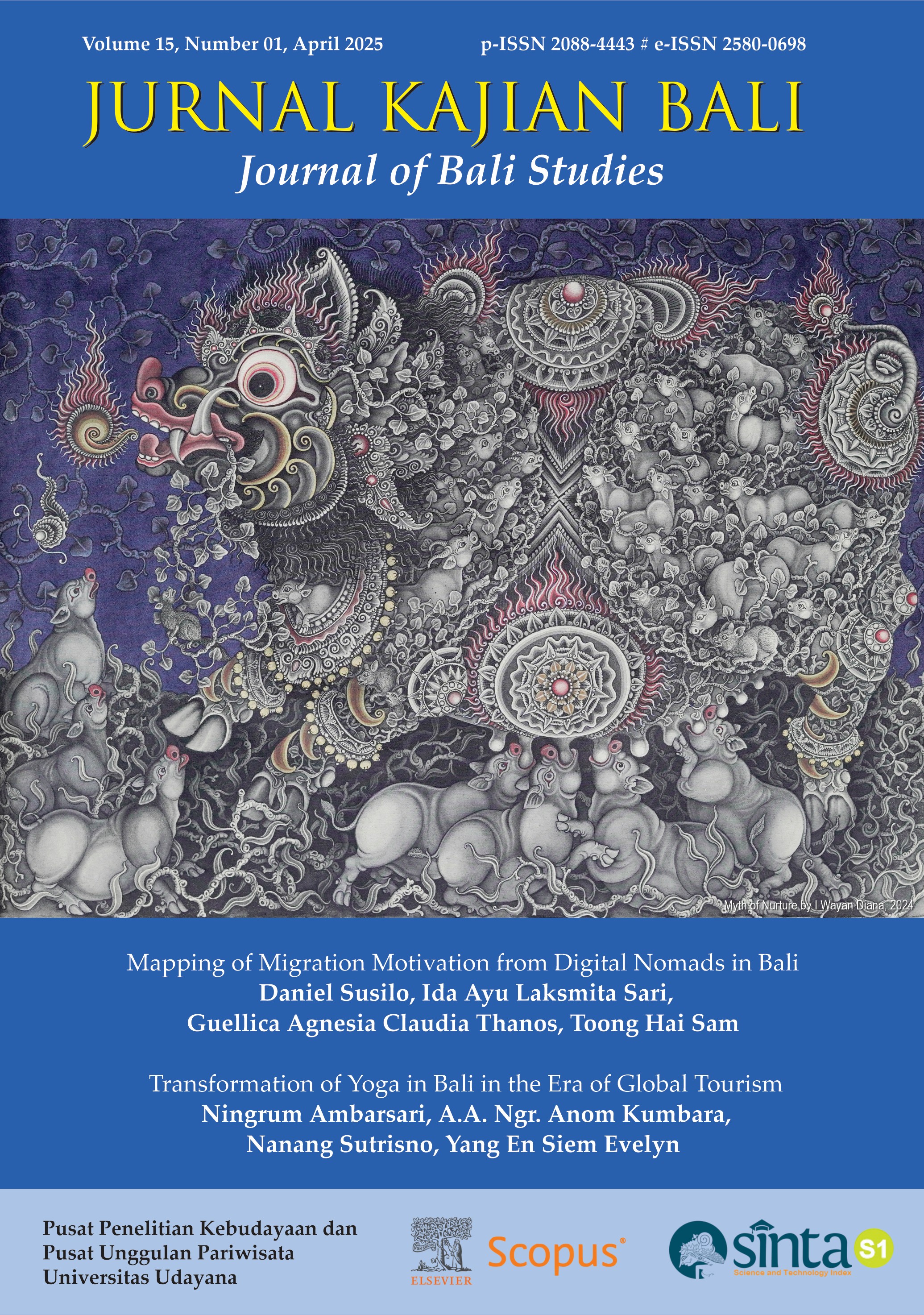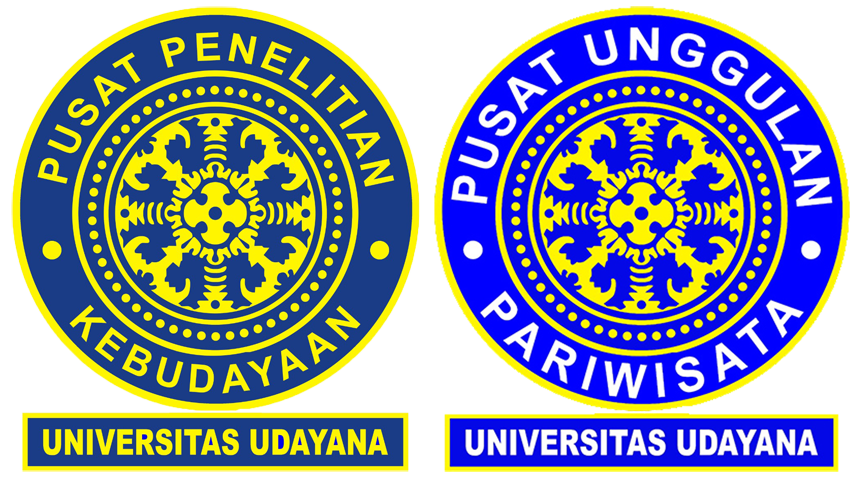Transformation of Yoga in Bali in the Era of Global Tourism
Abstract
The dynamic interplay of globalization and spiritual tradition creates a cultural synthesis. This study examines the transformation of yoga practices in Bali as driven by global consumerism. Using a qualitative approach, the research draws on observations and interviews with studio founders in Ubud, Seminyak, and Denpasar. The study identifies four main areas: ideology, practices, management, and symbols. The results show a shift from spiritual practices to commercialized wellness routines. Western-run studios emphasize commercial interests through paid services and international branding, while local founders favor community-focused approaches. The adaptation of Hindu spiritual symbols reflects a move away from cultural specificity and raises concerns about the erosion of local heritage. This research contributes to understanding how Bali’s deep-rooted rituals integrate with modern yoga practices introduced by global tourism. It highlights resistance to homogenization while honouring both tradition and new practices, adapting to modern influences without losing unique original values.
Downloads
References
Ambarsari, N. (2022). Cultural Shift on Spiritual Tourism in Bali Indonesia: Mediating roles of Empowerment, Cultural Diplomacy & Innovation. Proceeding International Conference of Interreligious and Intercultural Studies, Vol. 5, pp. 328–339. UNHI Press.
Antony, M. (2018). That’s a Stretch: Reconstructing, Rearticulating, and Commodifying Yoga. Frontier Communication, 3(47). doi: 10.3389/fcomm.2018.00047
Ariantini. (2021). Pergeseran Makna Ritual Yoga dalam Agama Hindu dari Sakral hingga Menjadi Konsumsi Publik. Vidya Wertta, 4(2), 82-90. https://ejournal.unhi.ac.id/index.php/vidyawertta/article/view/2159
Ashraf, N. (2016). Michel Foucault: A brief Introduction to Major Foucaultian Themes. Researchgate, 1-21. doi: 10.13140/RG.2.1.4789.5446
Bowers, H., & Cheer, J. (2017). Yoga tourism: Commodification and western embracement of eastern spiritual practice. Tourism Management Perspectives. doi:http://dx.doi.org/10.1016/j.tmp.2017.07.013.
Bourdieu, P. (1986). The Forms of Capital, Handbook of Theory and Research for the Sociology of Education. Greenwood Press.
Dewa, M. (2024). The Impact of Tourism on the Preservation and Transformation of Cultural Identity in Bali, Indonesia. Studies in Social Science & Humanities, 3(6), 34-41. doi:10.56397/SSSH.2024.06.05.
Foucault, M. (2002). Archaeology of Knowledge. Routledge.
Hemamalini, K. (2018). Consumerism in Commodification of Yoga Practices as Profanization in Yoga Culture Industry. Proceeding International Seminar (ICHECY) Communication of Religion, Hindu Dharma Nusantara Institute, 49-52.
Herviana, & Budiawan (2022). Proses Komodifikasi Yoga dalam Pariwisata Bali: Studi Etnografi pada Studio Yoga Barn, Ubud. Masters Thesis. Universitas Gadjah Mada.
Kadek, W. (2022). Bali Tourism Research Trends: A Systematic Review, 1976–2022. Journal of Bali Studies, 12(2), 600-626. doi:10.24843/JKB.2022.v12.i02.p14.
Karuniati, N. N., & Sugiantiningsih, A. A. (2022). Yoga Inner Beauty as a Lifestyle Among Women at the Ghanta Yoga Asram, Kertalangu Village, East Denpasar. International Journal of Social Science Research and Review, 5(9), 611-628. doi:http://dx.doi.org/10.47814/ijssrr.v5i9.661
Maharani, I. A. (2023). Mengungkap Kesuksesan: Perumusan Strategi untuk Yoga Barn Ubud Berdasarkan Ulasan Tripadvisory dan Analisis SWOT. Pariwisata Budaya Jurnal Ilmiah Agama dan Budaya, 400-55. doi: 10.25078/pariwisata.v8i2.2824
Mahendra, D. (2024). The Impact of Tourism on the Preservation and Transformation of Cultural Identity in Bali, Indonesia. Studies in Social Science & Humanities, 3(6), 34-41. doi:10.56397/SSSH.2024.06.05.
Mediastari, A. A. (2020). Local Wisdom Traditional Medicine for the Health and Beauty of Postpartum Mother in Denpasar City, Bali Province, Indonesia. International Journal of Health & Medical Sciences, 3(1), 65-71. doi:https://doi.org/10.31295/ijhms.v3n1.149
Meikassandra, & Prabawa. (2020). Wellness Tourism In Ubud. “A Qualitative Approach To Study The Aspects Of Welness Tourism Development”. Journal of Business on Hospitality and Tourism, 79-93. doi: https://dx.doi.org/10.22334/jbhost.v6i1.
Michels, S. (2004). Nietzsche and the Religion of the Future. A Philosophical Journal for Our Time, Secularity and religion issue, 52-72.
Nurwarsih, N. W., & Putra, I. N. (2021). The Dynamics of Productive and Non-Productive Spaces in Coastal Tourism Areas in Denpasar. IOP Conference Series: Earth and Environmental Science (pp. 1-14). Montreal: Purposed Led Publishing. doi:10.1088/1755-1315/764/1/012035
Putra, A. A., Yasa, W. S., & Utama, I. W. (2022). The religious aesthetic power of Baris Tunggal dance in Ubud traditional village. International Journal of Health Sciences, 6(S7), 445–460. doi: https://doi.org/10.53730/ijhs.v6nS7.11160
Ramadhani, D. P., & Alamsyah, A. (2024). Exploring Tourists’ Behavioral Patterns in Bali’s Top-Rated Destinations: Perception and Mobility. Journal of Theory Appllied Electronnic Commerce Research, 19, 743–773.
doi: https://doi.org/ 10.3390/jtaer19020040
Retreats, B. Y. (2023). Book Yoga Retreats. Retrieved from Book Yoga Retreats: https://www.bookyogaretreats.com/
Saitya, & Suryanti, P. E. (2021). Yoga dalam Pernaskahan Nusantara sebagai Daya Tarik Wisata di Bali. Pariwisata Budaya: Jurnal Ilmiah Pariwisata Agama dan Budaya, 35-41. doi: 10.36275/mws
Sanjaya, I. B., Wiarti, L. Y., & Susianti, H. W. (2024). Priority of Development Strategies for Wellness Tourism in Denpasar City. Tourism Research Journal, 8(1). doi: https://doi.org/10.30647/trj.v8i1.246
Shearer, M. (2022). Mantras and Monetization: The Commodification of Yoga and Culture . Virginia Sports and Entertainment Law Journal , 21(1). https://dx.doi.org/10.2139/ssrn.4190057
Sulastri, I. A. (2022). Analysis of Business Position to Determine The Marketing Strategy at The Kunja Villas & Spa Seminyak Bali. Jurnal Manajemen Pelayanan Hotel, 307-315. doi: http://dx.doi.org/10.37484/jmph.060201.
Surpi, K. (2021). Teks-Teks Klasik Yoga dan Refleksinya bagi Pengajaran Yoga di Bali. Jurnal Yoga dan Kesehatan, 163-176. doi: 10.25078/jyk.v4i2.2547.
Susanti, H. &. (2021). Wellness tourism as a form of adaptation to the dynamics of Bali tourism in the new normal era. 7th International Conference of Interreligious and Intercultural Studies (ICIIS), 24-37. doi: 10.24815.jsu.v16i1.24744.
Sutarya, I. G. (2018). Keunggulan Kompetitif Guru Yoga Lokal dalam Pariwisata Spiritual di Bali. (Hasil Penelitian). IHDN Denpasar.
Tadvalkar, N. (2015). A Language of Symbols: Rangoli Art of India. Traditional Knowledge and Traditional Cultural Expressions of South Asia, 173-186.
Thakur, M. (2014). A Creative Expression of Celebrations: Rangoli. International Journal of Research Granthaalayah. 2 (3SE), 1–3. https://doi.org/10.29121/granthaalayah.v2.i3SE.2014.3523
Utama, I. W. (2018). Ketika Yoga sebagai Gaya Hidup. Retrieved April 24, 2023, from https://www.unhi.ac.id/id/agama-budaya/detail-agama-budaya/Ketika-Yoga-sebagai-Gaya-Hidup
Wijaya, P. U., Warto, & Mahendra. (2018). The Authencity Of Yoga as Tourist Special Interest in Ubud Bali. Proceeding of International Conference on Art, Language, and Culture. Universitas Sebelas Maret.
Yoga Alliance Foundation. (2020). Our History. https://r.yogaalliance.org/About_Us/Our_History

This work is licensed under a Creative Commons Attribution 4.0 International License.



















